Financial Analysis Assignment: Detailed Analysis and Calculations
VerifiedAdded on 2020/05/28
|38
|7207
|71
Homework Assignment
AI Summary
This document presents a comprehensive financial analysis assignment solution. It begins with an analysis of a company's profits, dividend income, and consumption, including calculations for available balance and closing balance over two years. Part B delves into dividend discount models, calculating present values of dividends and expected market prices. The assignment then moves into investment and loan analysis, determining amounts available in funds, pension payments, effective interest rates, and loan installments. It explores payback periods for different investment projects under both even and uneven cash flows, calculating NPV and IRR. The final section analyzes the financial implications of a technology purchase, assessing the impact on labor costs, depreciation, and tax benefits, ultimately determining whether the purchase is financially viable.

Running Head: Financial Analysis
Financial Management
Financial Management
Paraphrase This Document
Need a fresh take? Get an instant paraphrase of this document with our AI Paraphraser
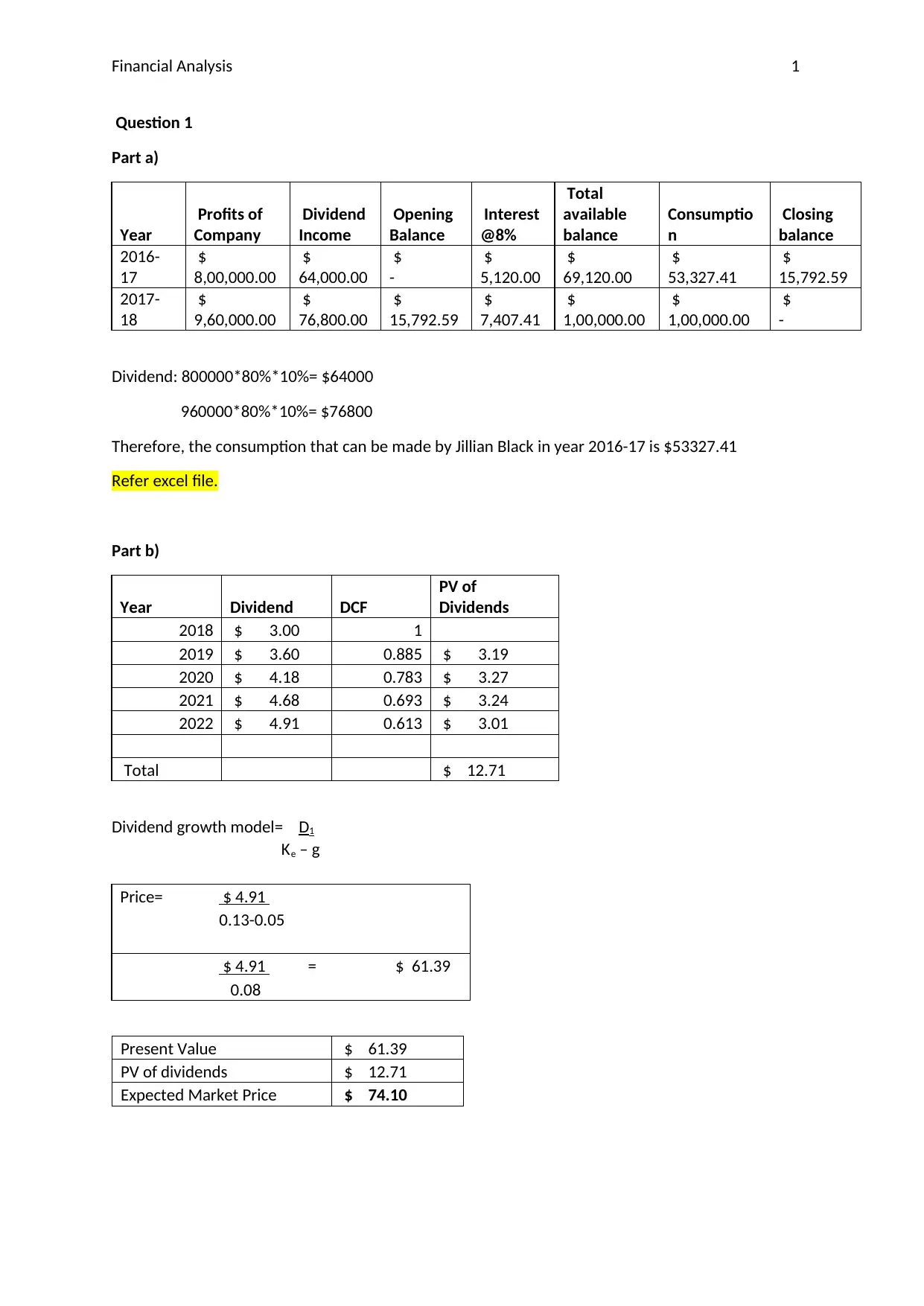
Financial Analysis 1
Question 1
Part a)
Year
Profits of
Company
Dividend
Income
Opening
Balance
Interest
@8%
Total
available
balance
Consumptio
n
Closing
balance
2016-
17
$
8,00,000.00
$
64,000.00
$
-
$
5,120.00
$
69,120.00
$
53,327.41
$
15,792.59
2017-
18
$
9,60,000.00
$
76,800.00
$
15,792.59
$
7,407.41
$
1,00,000.00
$
1,00,000.00
$
-
Dividend: 800000*80%*10%= $64000
960000*80%*10%= $76800
Therefore, the consumption that can be made by Jillian Black in year 2016-17 is $53327.41
Refer excel file.
Part b)
Year Dividend DCF
PV of
Dividends
2018 $ 3.00 1
2019 $ 3.60 0.885 $ 3.19
2020 $ 4.18 0.783 $ 3.27
2021 $ 4.68 0.693 $ 3.24
2022 $ 4.91 0.613 $ 3.01
Total $ 12.71
Dividend growth model= D1
Ke – g
Price= $ 4.91
0.13-0.05
$ 4.91 = $ 61.39
0.08
Present Value $ 61.39
PV of dividends $ 12.71
Expected Market Price $ 74.10
Question 1
Part a)
Year
Profits of
Company
Dividend
Income
Opening
Balance
Interest
@8%
Total
available
balance
Consumptio
n
Closing
balance
2016-
17
$
8,00,000.00
$
64,000.00
$
-
$
5,120.00
$
69,120.00
$
53,327.41
$
15,792.59
2017-
18
$
9,60,000.00
$
76,800.00
$
15,792.59
$
7,407.41
$
1,00,000.00
$
1,00,000.00
$
-
Dividend: 800000*80%*10%= $64000
960000*80%*10%= $76800
Therefore, the consumption that can be made by Jillian Black in year 2016-17 is $53327.41
Refer excel file.
Part b)
Year Dividend DCF
PV of
Dividends
2018 $ 3.00 1
2019 $ 3.60 0.885 $ 3.19
2020 $ 4.18 0.783 $ 3.27
2021 $ 4.68 0.693 $ 3.24
2022 $ 4.91 0.613 $ 3.01
Total $ 12.71
Dividend growth model= D1
Ke – g
Price= $ 4.91
0.13-0.05
$ 4.91 = $ 61.39
0.08
Present Value $ 61.39
PV of dividends $ 12.71
Expected Market Price $ 74.10
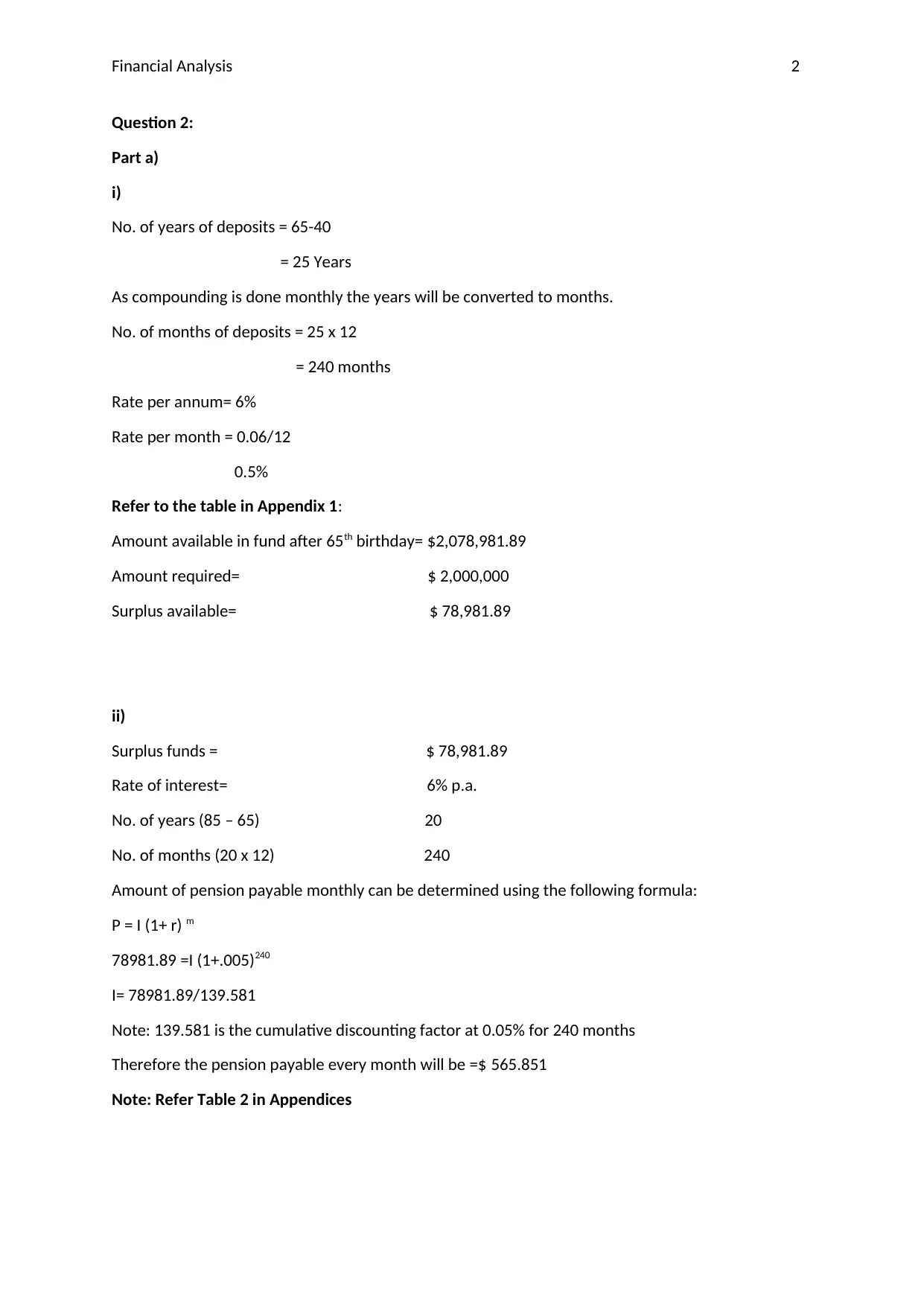
Financial Analysis 2
Question 2:
Part a)
i)
No. of years of deposits = 65-40
= 25 Years
As compounding is done monthly the years will be converted to months.
No. of months of deposits = 25 x 12
= 240 months
Rate per annum= 6%
Rate per month = 0.06/12
0.5%
Refer to the table in Appendix 1:
Amount available in fund after 65th birthday= $2,078,981.89
Amount required= $ 2,000,000
Surplus available= $ 78,981.89
ii)
Surplus funds = $ 78,981.89
Rate of interest= 6% p.a.
No. of years (85 – 65) 20
No. of months (20 x 12) 240
Amount of pension payable monthly can be determined using the following formula:
P = I (1+ r) m
78981.89 =I (1+.005)240
I= 78981.89/139.581
Note: 139.581 is the cumulative discounting factor at 0.05% for 240 months
Therefore the pension payable every month will be =$ 565.851
Note: Refer Table 2 in Appendices
Question 2:
Part a)
i)
No. of years of deposits = 65-40
= 25 Years
As compounding is done monthly the years will be converted to months.
No. of months of deposits = 25 x 12
= 240 months
Rate per annum= 6%
Rate per month = 0.06/12
0.5%
Refer to the table in Appendix 1:
Amount available in fund after 65th birthday= $2,078,981.89
Amount required= $ 2,000,000
Surplus available= $ 78,981.89
ii)
Surplus funds = $ 78,981.89
Rate of interest= 6% p.a.
No. of years (85 – 65) 20
No. of months (20 x 12) 240
Amount of pension payable monthly can be determined using the following formula:
P = I (1+ r) m
78981.89 =I (1+.005)240
I= 78981.89/139.581
Note: 139.581 is the cumulative discounting factor at 0.05% for 240 months
Therefore the pension payable every month will be =$ 565.851
Note: Refer Table 2 in Appendices
⊘ This is a preview!⊘
Do you want full access?
Subscribe today to unlock all pages.

Trusted by 1+ million students worldwide

Financial Analysis 3
Part b)
i)
Effective Rate Formula: I = (1+ (r/m) )m −1
(1 + (0.048/12))12-1
4.907%
ii)
Loan amount= Instalment(1+r)t
T 240
R 0.004
600000= Instalment (1+.004)240
Instalment Amount= $ 3893.74
iii)
For the first 12 months the instalment will be $3500. In this instalment, both principle and interest
will be calculated on the opening balance of loan every year.
After 12 months, the instalment amount will be changed and it will be $3750. This instalment will
also include the principle and interest.
Remaining period will be calculated as follows:
Retirement age= 65th year.
Pension fund will be fully paid at the end of 85th year
Number of years = 20 years.
Number of months= 20 x 12 = 240 months.
Remaining months= 240 – 12-12
= 216 Months.
Cumulative discounting factor @ 0.04% per month = 144.50
Therefore, the instalment amount will be= Amount outstanding after 24th Month
Cumulative discounting factor @ 0.04%
=$ 571,856.23/144.50
=$3958.85
The above calculated amount also includes both principle and interest amount.
Note= Refer Table 3 in Appendices
Part b)
i)
Effective Rate Formula: I = (1+ (r/m) )m −1
(1 + (0.048/12))12-1
4.907%
ii)
Loan amount= Instalment(1+r)t
T 240
R 0.004
600000= Instalment (1+.004)240
Instalment Amount= $ 3893.74
iii)
For the first 12 months the instalment will be $3500. In this instalment, both principle and interest
will be calculated on the opening balance of loan every year.
After 12 months, the instalment amount will be changed and it will be $3750. This instalment will
also include the principle and interest.
Remaining period will be calculated as follows:
Retirement age= 65th year.
Pension fund will be fully paid at the end of 85th year
Number of years = 20 years.
Number of months= 20 x 12 = 240 months.
Remaining months= 240 – 12-12
= 216 Months.
Cumulative discounting factor @ 0.04% per month = 144.50
Therefore, the instalment amount will be= Amount outstanding after 24th Month
Cumulative discounting factor @ 0.04%
=$ 571,856.23/144.50
=$3958.85
The above calculated amount also includes both principle and interest amount.
Note= Refer Table 3 in Appendices
Paraphrase This Document
Need a fresh take? Get an instant paraphrase of this document with our AI Paraphraser

Financial Analysis 4
iv)
Loan amount= $ 600000
Interest rate= 4.8% p.a.
Loan = Instalment (1+r)t
600000= Instalment (1 + .004)t
Time year= 24.17 Years
24 years and 2.04 months.
Note: Refer Table 4 in Appendices
v)
The extra amount paid over and above the loan is $ 204.231 due to the rounding off factor used in calculation.
Therefore, the amount of final repayment is $ 600204.231
Note: Refer Table 4 in Appendices
Question 3
Part i)
As cash flows are given uneven in the question the average cash flow of 3 years is assumed to occur
evenly for the purpose of calculation of payback period.
=12000+18000+27000
3
=19000
Investment X Investment Y
Year Cash Flows Cash Flows
0 $ -42,000.00 $ -42,000.00
1 $ 19,000.00 $ 18,000.00
2 $ 19,000.00 $ 18,000.00
3 $ 19,000.00 $ 18,000.00
Payback Period (Years) 2.21 2.33
Note: Project X will be preferred over Project Y as it has lower payback period.
Part ii)
Investment X Investment Y
Year Cash Flows Cumulative CFs Cash Flows
0 $ -42,000.00 $ -42,000.00 $ -42,000.00
1 $ 12,000.00 $ -30,000.00 $ 18,000.00
2 $ 18,000.00 $ -12,000.00 $ 18,000.00
iv)
Loan amount= $ 600000
Interest rate= 4.8% p.a.
Loan = Instalment (1+r)t
600000= Instalment (1 + .004)t
Time year= 24.17 Years
24 years and 2.04 months.
Note: Refer Table 4 in Appendices
v)
The extra amount paid over and above the loan is $ 204.231 due to the rounding off factor used in calculation.
Therefore, the amount of final repayment is $ 600204.231
Note: Refer Table 4 in Appendices
Question 3
Part i)
As cash flows are given uneven in the question the average cash flow of 3 years is assumed to occur
evenly for the purpose of calculation of payback period.
=12000+18000+27000
3
=19000
Investment X Investment Y
Year Cash Flows Cash Flows
0 $ -42,000.00 $ -42,000.00
1 $ 19,000.00 $ 18,000.00
2 $ 19,000.00 $ 18,000.00
3 $ 19,000.00 $ 18,000.00
Payback Period (Years) 2.21 2.33
Note: Project X will be preferred over Project Y as it has lower payback period.
Part ii)
Investment X Investment Y
Year Cash Flows Cumulative CFs Cash Flows
0 $ -42,000.00 $ -42,000.00 $ -42,000.00
1 $ 12,000.00 $ -30,000.00 $ 18,000.00
2 $ 18,000.00 $ -12,000.00 $ 18,000.00

Financial Analysis 5
3 $ 27,000.00 $ 15,000.00 $ 18,000.00
Payback
Period (Years) 2.44 2.33
Yes, the payback period would be different in case of uneven cash flows and it will be increased.
3 $ 27,000.00 $ 15,000.00 $ 18,000.00
Payback
Period (Years) 2.44 2.33
Yes, the payback period would be different in case of uneven cash flows and it will be increased.
⊘ This is a preview!⊘
Do you want full access?
Subscribe today to unlock all pages.

Trusted by 1+ million students worldwide
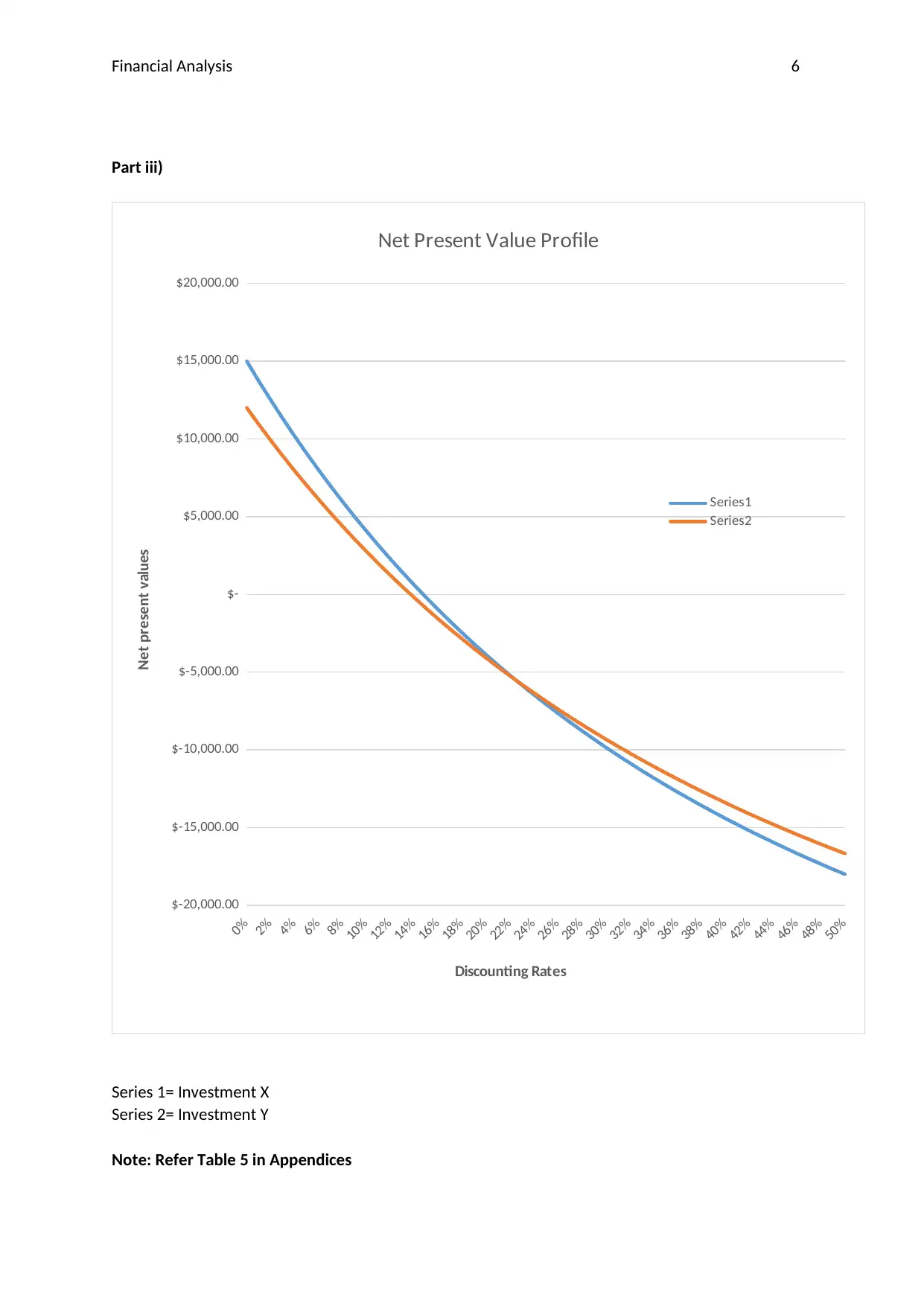
Financial Analysis 6
Part iii)
0%
2%
4%
6%
8%
10%
12%
14%
16%
18%
20%
22%
24%
26%
28%
30%
32%
34%
36%
38%
40%
42%
44%
46%
48%
50%
$-20,000.00
$-15,000.00
$-10,000.00
$-5,000.00
$-
$5,000.00
$10,000.00
$15,000.00
$20,000.00
Net Present Value Profile
Series1
Series2
Discounting Rates
Net present values
Series 1= Investment X
Series 2= Investment Y
Note: Refer Table 5 in Appendices
Part iii)
0%
2%
4%
6%
8%
10%
12%
14%
16%
18%
20%
22%
24%
26%
28%
30%
32%
34%
36%
38%
40%
42%
44%
46%
48%
50%
$-20,000.00
$-15,000.00
$-10,000.00
$-5,000.00
$-
$5,000.00
$10,000.00
$15,000.00
$20,000.00
Net Present Value Profile
Series1
Series2
Discounting Rates
Net present values
Series 1= Investment X
Series 2= Investment Y
Note: Refer Table 5 in Appendices
Paraphrase This Document
Need a fresh take? Get an instant paraphrase of this document with our AI Paraphraser
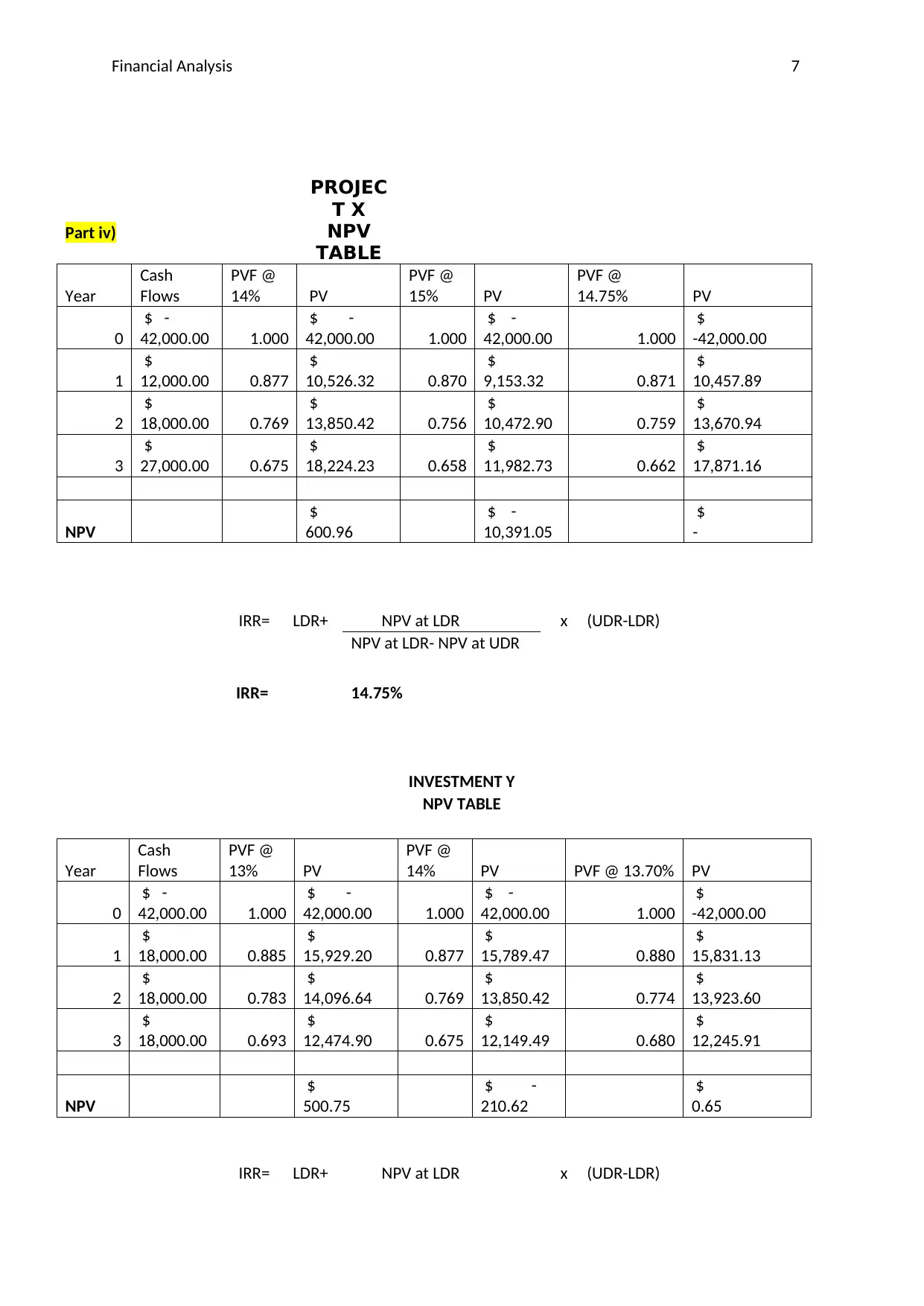
Financial Analysis 7
Part iv)
PROJEC
T X
NPV
TABLE
Year
Cash
Flows
PVF @
14% PV
PVF @
15% PV
PVF @
14.75% PV
0
$ -
42,000.00 1.000
$ -
42,000.00 1.000
$ -
42,000.00 1.000
$
-42,000.00
1
$
12,000.00 0.877
$
10,526.32 0.870
$
9,153.32 0.871
$
10,457.89
2
$
18,000.00 0.769
$
13,850.42 0.756
$
10,472.90 0.759
$
13,670.94
3
$
27,000.00 0.675
$
18,224.23 0.658
$
11,982.73 0.662
$
17,871.16
NPV
$
600.96
$ -
10,391.05
$
-
IRR= LDR+ NPV at LDR x (UDR-LDR)
NPV at LDR- NPV at UDR
IRR= 14.75%
INVESTMENT Y
NPV TABLE
Year
Cash
Flows
PVF @
13% PV
PVF @
14% PV PVF @ 13.70% PV
0
$ -
42,000.00 1.000
$ -
42,000.00 1.000
$ -
42,000.00 1.000
$
-42,000.00
1
$
18,000.00 0.885
$
15,929.20 0.877
$
15,789.47 0.880
$
15,831.13
2
$
18,000.00 0.783
$
14,096.64 0.769
$
13,850.42 0.774
$
13,923.60
3
$
18,000.00 0.693
$
12,474.90 0.675
$
12,149.49 0.680
$
12,245.91
NPV
$
500.75
$ -
210.62
$
0.65
IRR= LDR+ NPV at LDR x (UDR-LDR)
Part iv)
PROJEC
T X
NPV
TABLE
Year
Cash
Flows
PVF @
14% PV
PVF @
15% PV
PVF @
14.75% PV
0
$ -
42,000.00 1.000
$ -
42,000.00 1.000
$ -
42,000.00 1.000
$
-42,000.00
1
$
12,000.00 0.877
$
10,526.32 0.870
$
9,153.32 0.871
$
10,457.89
2
$
18,000.00 0.769
$
13,850.42 0.756
$
10,472.90 0.759
$
13,670.94
3
$
27,000.00 0.675
$
18,224.23 0.658
$
11,982.73 0.662
$
17,871.16
NPV
$
600.96
$ -
10,391.05
$
-
IRR= LDR+ NPV at LDR x (UDR-LDR)
NPV at LDR- NPV at UDR
IRR= 14.75%
INVESTMENT Y
NPV TABLE
Year
Cash
Flows
PVF @
13% PV
PVF @
14% PV PVF @ 13.70% PV
0
$ -
42,000.00 1.000
$ -
42,000.00 1.000
$ -
42,000.00 1.000
$
-42,000.00
1
$
18,000.00 0.885
$
15,929.20 0.877
$
15,789.47 0.880
$
15,831.13
2
$
18,000.00 0.783
$
14,096.64 0.769
$
13,850.42 0.774
$
13,923.60
3
$
18,000.00 0.693
$
12,474.90 0.675
$
12,149.49 0.680
$
12,245.91
NPV
$
500.75
$ -
210.62
$
0.65
IRR= LDR+ NPV at LDR x (UDR-LDR)

Financial Analysis 8
NPV at LDR- NPV at UDR
IRR= 13.70%
13.00% 13.70% 14.00% 14.75% 15.00%
-12000.000
-10000.000
-8000.000
-6000.000
-4000.000
-2000.000
0.000
2000.000
4000.000
Chart Title
Series1 Series2
Series 1= Investment X
Series 2= Investment Y
Note: Refer Table 6 in appendices.
Part v)
Project X Cash Flows
Project Y Cash
Flows Difference
0 $ -42,000.00
$ -
42,000.00 $ -
1 $ 12,000.00
$
18,000.00 $ -6,000.00
2 $ 18,000.00
$
18,000.00 $ -
3 $ 27,000.00
$
18,000.00 $ 9,000.00
Crossover Point 22.47%
NPV at LDR- NPV at UDR
IRR= 13.70%
13.00% 13.70% 14.00% 14.75% 15.00%
-12000.000
-10000.000
-8000.000
-6000.000
-4000.000
-2000.000
0.000
2000.000
4000.000
Chart Title
Series1 Series2
Series 1= Investment X
Series 2= Investment Y
Note: Refer Table 6 in appendices.
Part v)
Project X Cash Flows
Project Y Cash
Flows Difference
0 $ -42,000.00
$ -
42,000.00 $ -
1 $ 12,000.00
$
18,000.00 $ -6,000.00
2 $ 18,000.00
$
18,000.00 $ -
3 $ 27,000.00
$
18,000.00 $ 9,000.00
Crossover Point 22.47%
⊘ This is a preview!⊘
Do you want full access?
Subscribe today to unlock all pages.

Trusted by 1+ million students worldwide
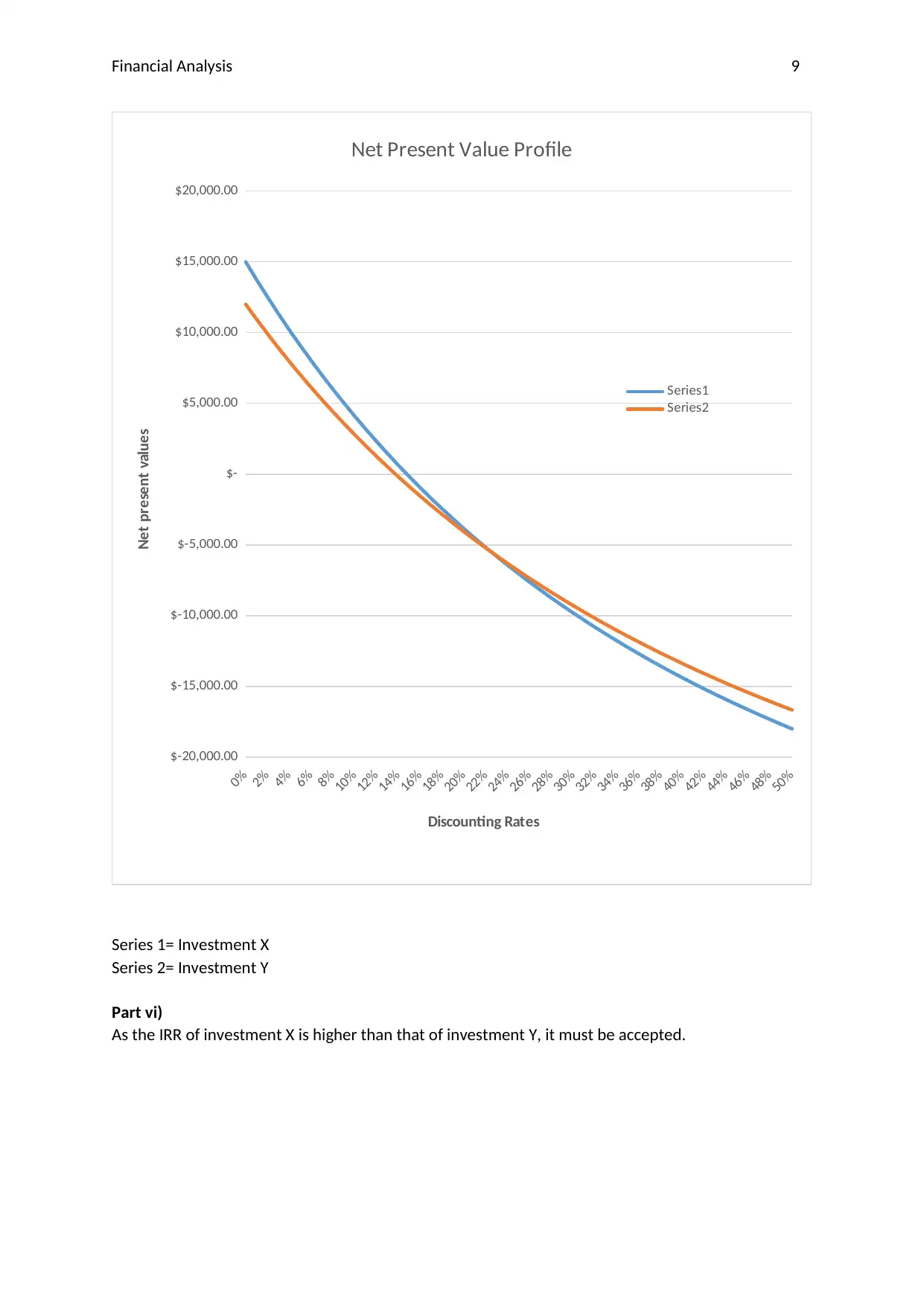
Financial Analysis 9
0%
2%
4%
6%
8%
10%
12%
14%
16%
18%
20%
22%
24%
26%
28%
30%
32%
34%
36%
38%
40%
42%
44%
46%
48%
50%
$-20,000.00
$-15,000.00
$-10,000.00
$-5,000.00
$-
$5,000.00
$10,000.00
$15,000.00
$20,000.00
Net Present Value Profile
Series1
Series2
Discounting Rates
Net present values
Series 1= Investment X
Series 2= Investment Y
Part vi)
As the IRR of investment X is higher than that of investment Y, it must be accepted.
0%
2%
4%
6%
8%
10%
12%
14%
16%
18%
20%
22%
24%
26%
28%
30%
32%
34%
36%
38%
40%
42%
44%
46%
48%
50%
$-20,000.00
$-15,000.00
$-10,000.00
$-5,000.00
$-
$5,000.00
$10,000.00
$15,000.00
$20,000.00
Net Present Value Profile
Series1
Series2
Discounting Rates
Net present values
Series 1= Investment X
Series 2= Investment Y
Part vi)
As the IRR of investment X is higher than that of investment Y, it must be accepted.
Paraphrase This Document
Need a fresh take? Get an instant paraphrase of this document with our AI Paraphraser
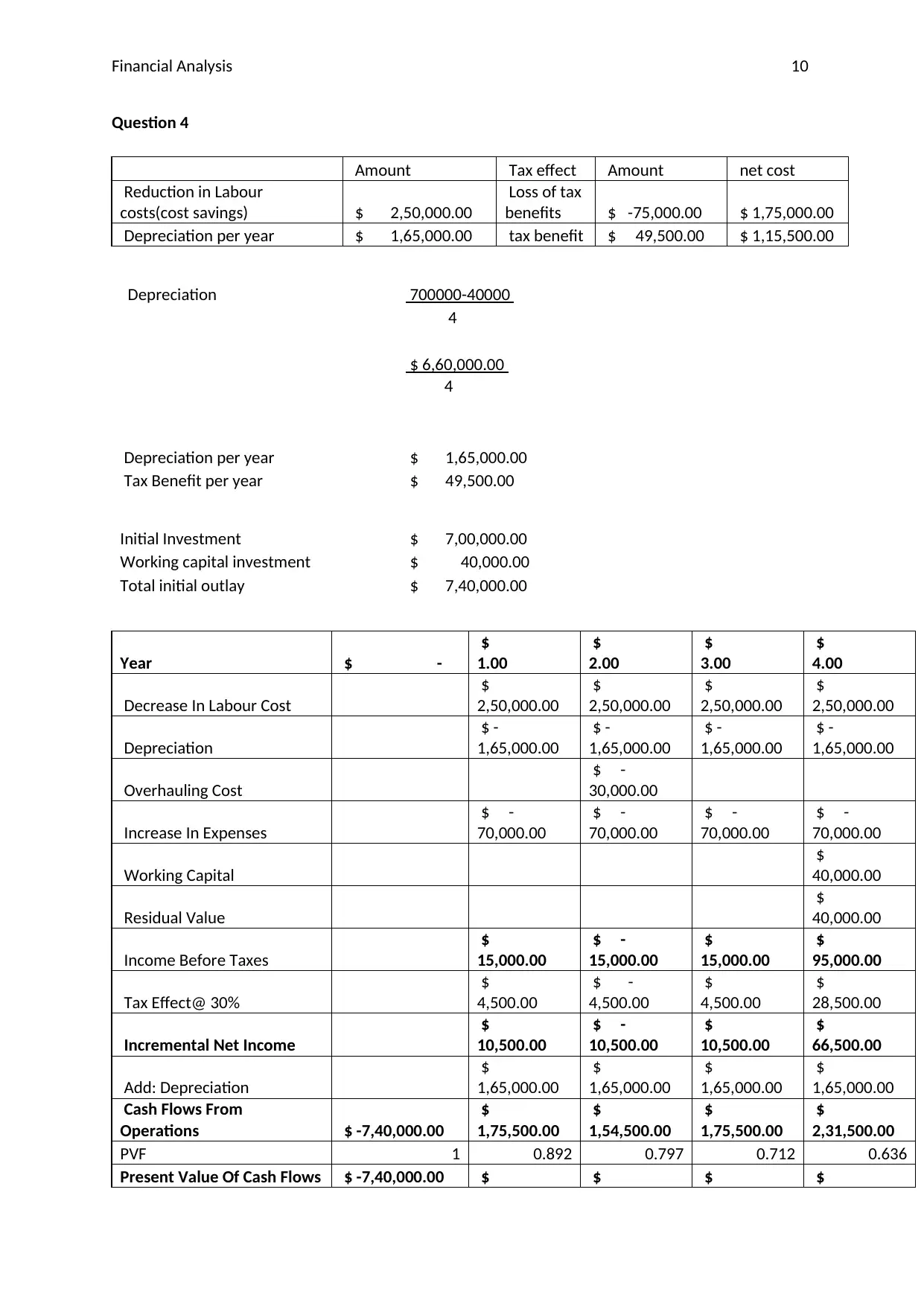
Financial Analysis 10
Question 4
Amount Tax effect Amount net cost
Reduction in Labour
costs(cost savings) $ 2,50,000.00
Loss of tax
benefits $ -75,000.00 $ 1,75,000.00
Depreciation per year $ 1,65,000.00 tax benefit $ 49,500.00 $ 1,15,500.00
Depreciation 700000-40000
4
$ 6,60,000.00
4
Depreciation per year $ 1,65,000.00
Tax Benefit per year $ 49,500.00
Initial Investment $ 7,00,000.00
Working capital investment $ 40,000.00
Total initial outlay $ 7,40,000.00
Year $ -
$
1.00
$
2.00
$
3.00
$
4.00
Decrease In Labour Cost
$
2,50,000.00
$
2,50,000.00
$
2,50,000.00
$
2,50,000.00
Depreciation
$ -
1,65,000.00
$ -
1,65,000.00
$ -
1,65,000.00
$ -
1,65,000.00
Overhauling Cost
$ -
30,000.00
Increase In Expenses
$ -
70,000.00
$ -
70,000.00
$ -
70,000.00
$ -
70,000.00
Working Capital
$
40,000.00
Residual Value
$
40,000.00
Income Before Taxes
$
15,000.00
$ -
15,000.00
$
15,000.00
$
95,000.00
Tax Effect@ 30%
$
4,500.00
$ -
4,500.00
$
4,500.00
$
28,500.00
Incremental Net Income
$
10,500.00
$ -
10,500.00
$
10,500.00
$
66,500.00
Add: Depreciation
$
1,65,000.00
$
1,65,000.00
$
1,65,000.00
$
1,65,000.00
Cash Flows From
Operations $ -7,40,000.00
$
1,75,500.00
$
1,54,500.00
$
1,75,500.00
$
2,31,500.00
PVF 1 0.892 0.797 0.712 0.636
Present Value Of Cash Flows $ -7,40,000.00 $ $ $ $
Question 4
Amount Tax effect Amount net cost
Reduction in Labour
costs(cost savings) $ 2,50,000.00
Loss of tax
benefits $ -75,000.00 $ 1,75,000.00
Depreciation per year $ 1,65,000.00 tax benefit $ 49,500.00 $ 1,15,500.00
Depreciation 700000-40000
4
$ 6,60,000.00
4
Depreciation per year $ 1,65,000.00
Tax Benefit per year $ 49,500.00
Initial Investment $ 7,00,000.00
Working capital investment $ 40,000.00
Total initial outlay $ 7,40,000.00
Year $ -
$
1.00
$
2.00
$
3.00
$
4.00
Decrease In Labour Cost
$
2,50,000.00
$
2,50,000.00
$
2,50,000.00
$
2,50,000.00
Depreciation
$ -
1,65,000.00
$ -
1,65,000.00
$ -
1,65,000.00
$ -
1,65,000.00
Overhauling Cost
$ -
30,000.00
Increase In Expenses
$ -
70,000.00
$ -
70,000.00
$ -
70,000.00
$ -
70,000.00
Working Capital
$
40,000.00
Residual Value
$
40,000.00
Income Before Taxes
$
15,000.00
$ -
15,000.00
$
15,000.00
$
95,000.00
Tax Effect@ 30%
$
4,500.00
$ -
4,500.00
$
4,500.00
$
28,500.00
Incremental Net Income
$
10,500.00
$ -
10,500.00
$
10,500.00
$
66,500.00
Add: Depreciation
$
1,65,000.00
$
1,65,000.00
$
1,65,000.00
$
1,65,000.00
Cash Flows From
Operations $ -7,40,000.00
$
1,75,500.00
$
1,54,500.00
$
1,75,500.00
$
2,31,500.00
PVF 1 0.892 0.797 0.712 0.636
Present Value Of Cash Flows $ -7,40,000.00 $ $ $ $
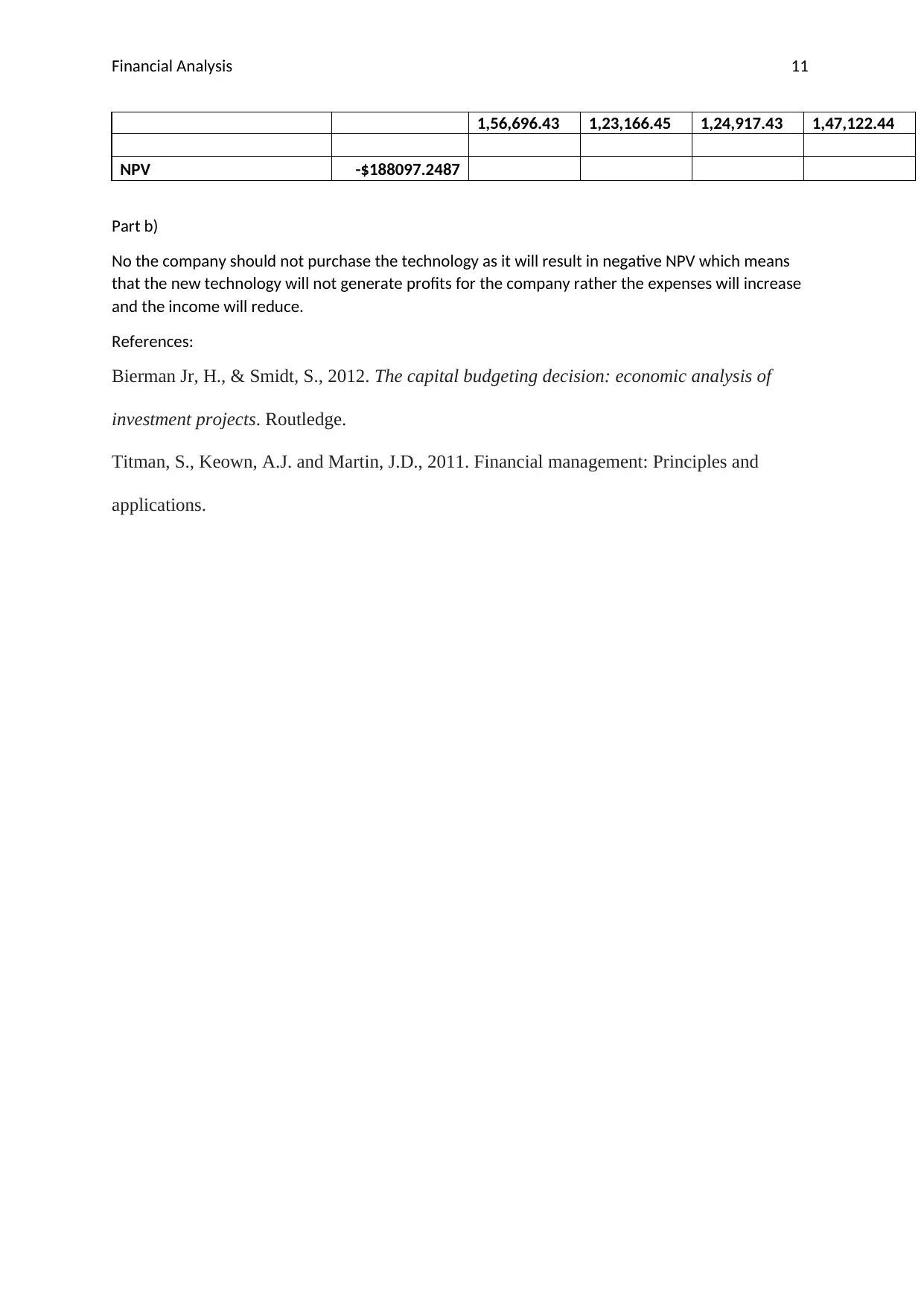
Financial Analysis 11
1,56,696.43 1,23,166.45 1,24,917.43 1,47,122.44
NPV -$188097.2487
Part b)
No the company should not purchase the technology as it will result in negative NPV which means
that the new technology will not generate profits for the company rather the expenses will increase
and the income will reduce.
References:
Bierman Jr, H., & Smidt, S., 2012. The capital budgeting decision: economic analysis of
investment projects. Routledge.
Titman, S., Keown, A.J. and Martin, J.D., 2011. Financial management: Principles and
applications.
1,56,696.43 1,23,166.45 1,24,917.43 1,47,122.44
NPV -$188097.2487
Part b)
No the company should not purchase the technology as it will result in negative NPV which means
that the new technology will not generate profits for the company rather the expenses will increase
and the income will reduce.
References:
Bierman Jr, H., & Smidt, S., 2012. The capital budgeting decision: economic analysis of
investment projects. Routledge.
Titman, S., Keown, A.J. and Martin, J.D., 2011. Financial management: Principles and
applications.
⊘ This is a preview!⊘
Do you want full access?
Subscribe today to unlock all pages.

Trusted by 1+ million students worldwide
1 out of 38
Related Documents
Your All-in-One AI-Powered Toolkit for Academic Success.
+13062052269
info@desklib.com
Available 24*7 on WhatsApp / Email
![[object Object]](/_next/static/media/star-bottom.7253800d.svg)
Unlock your academic potential
Copyright © 2020–2025 A2Z Services. All Rights Reserved. Developed and managed by ZUCOL.




